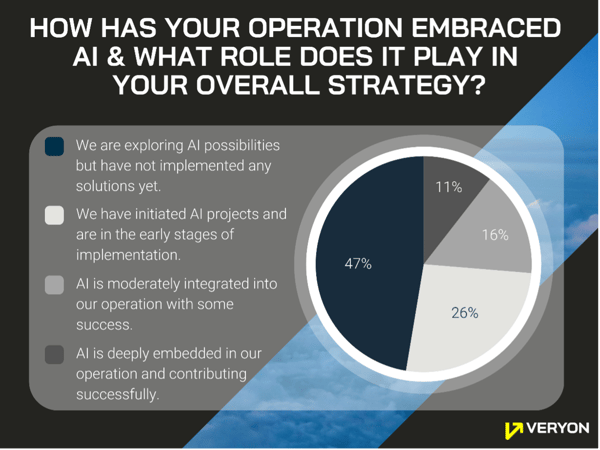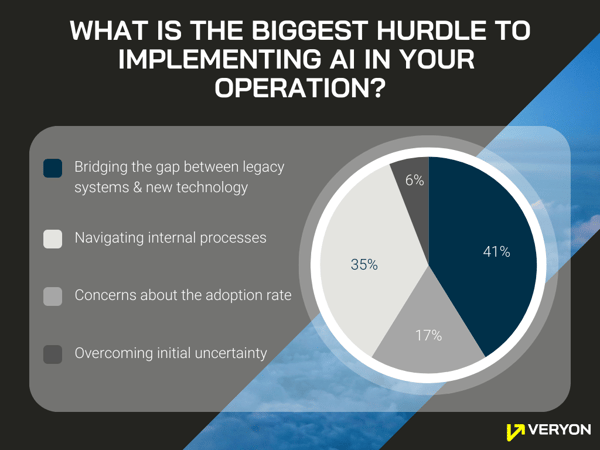6 min read
Flying Forward: Shifting from Proactive to Predictive Maintenance with Veryon Diagnostics
Veryon : Feb 13, 2024 8:00:00 AM
In the world of aviation where precision and safety are paramount, the quest for innovation never ceases. What would you think about the technology that could reduce troubleshooting time by 50 percent, reduce delays and cancellations by 10 percent, and lift fix rate by 5 percent? It sounds interesting, right?
One of the most transformative shifts within the industry is the migration from proactive to predictive maintenance, powered by artificial intelligence (AI) and machine learning (ML) technologies. This transition marks a pivotal moment in aviation, revolutionizing how operators can ensure aircraft reliability while minimizing unforeseen disruptions.
Traditionally, aircraft maintenance practices leaned heavily on proactive approaches —scheduled check-ups, routine inspections, and fixed maintenance intervals. While effective in addressing known issues, these methods often fall short in predicting and averting potential faults before they lead to operational disruptions.
This gap spurred a paradigm shift towards predictive maintenance, an approach centered on harnessing the power of data and predictive analytics to anticipate maintenance needs. With the popularity and usage of AI continuing to rise, we expect to see a trend of new products and solutions disrupting the industry, with AI forever embedded in the future of aviation.
In a recent webinar, Veryon polled aviation industry professionals to see how they have embraced AI in their overall maintenance operations thus far.
 AI has been dominating social media and news headlines, with most industries being open to its benefits, but as the poll shows, the aviation industry has remained somewhat apprehensive.
AI has been dominating social media and news headlines, with most industries being open to its benefits, but as the poll shows, the aviation industry has remained somewhat apprehensive.
"In aviation, we're generally hesitant to introduce change because we're a very safety-focused and regulated industry," said Victor Lee, Senior Customer Success Manager for Veryon. "Bringing in technology that hasn’t been proven will always be a risk, but I think that's our role at Veryon in this market...to really produce tools that assemble and make sense of vast information to surface the proven insights and actions. As more people are exposed to it, it'll become more integrated in the day-to-day."
Challenges in AI Integration
One of the most challenging aspects of incorporating AI revolves around concerns of data privacy and the substantial investment required to establish secure infrastructure. The safeguarding of sensitive data and the creation of robust systems demand considerable resources and attention.
"There is hesitation with AI in the aviation industry related to privacy and regulations such as the FAA," said Fedor Gorin, Senior Director of Engineering for Veryon. "The introduction of AI doesn't mean an operator's logbook data will become public or AMMs and FIMs are going to be leaked. It requires an investment to have secure infrastructure.”
A poll during the webinar also revealed another big hurdle companies face in implementing AI in their operations — bridging the gap between legacy systems and new technology.
 Yet, amidst these challenges, the aviation sector acknowledges the critical importance of quick and accurate information access. This recognition has led to a pivotal shift from traditional paper logbooks to electronic counterparts to enhance operational efficiency and reliability.
Yet, amidst these challenges, the aviation sector acknowledges the critical importance of quick and accurate information access. This recognition has led to a pivotal shift from traditional paper logbooks to electronic counterparts to enhance operational efficiency and reliability.
"We're trying to use these AI technologies to look at repeat issues and defects on a case-by-case basis and put that information in the hands of the maintenance technicians quickly and accurately," said Lee. "If they don't have access through a mobile device and rely on paper logbooks, they would have to go back to their office or work truck and dig through the
existing maintenance tracking systems to find what they are looking for."
Preserving Industry Experience Using AI
It's no secret that our industry faces a real challenge in the coming years. This recent article from Simply Flying highlights a widespread industry trend — the escalating demand for skilled workers in aviation, including pilots, maintenance staff, and operational teams.
Referencing Boeing's analysis, it's projected that the aviation sector will require an influx of approximately 2.2 million professionals over the next two decades to accommodate the surging needs of air travel and aircraft management. Additionally, Boeing anticipates that about 30 percent of all aviation services will integrate digital solutions and analytics within the same timeframe, highlighting the evolving technological landscape.
As the aviation industry faces a transition towards a less experienced technician workforce, leveraging AI technologies will become imperative. AI allows the capture and preservation of invaluable expertise, especially from retiring professionals, aiding in knowledge retention and transfer.
"Our industry is filled with smart individuals with a ton of experience, and we can't overlook that," said Gorin. "However, as mechanics retire and less experienced individuals take over, AI offers the capability to gather field knowledge through recorded videos, which can then be edited to document the troubleshooting and solutions attempted by the professionals."
Redefining Predictive Maintenance with Veryon Diagnostics
As Veryon continues to work towards an era of innovation with elevated standards, at the forefront of that is Veryon Diagnostics, a cloud-based platform designed explicitly for aircraft maintenance. Veryon's comprehensive system integrates seamlessly into existing workflows, leveraging AI-driven algorithms to analyze vast data streams from aircraft sensors, historical performance records, and real-time operational metrics.
At its core, Veryon Diagnostics isn't just a tool for fault detection; it's a catalyst for predictive insights. By processing and interpreting complex data patterns, Veryon equips maintenance teams with predictive capabilities to anticipate potential faults or component failures well in advance. This foresight empowers operators to proactively schedule maintenance interventions during planned downtimes, eliminating the risks associated with unexpected disruptions.
The primary goal behind leveraging Veryon Diagnostics is minimizing or eliminating the operational impact of unscheduled maintenance. Airlines can execute precise actions during scheduled maintenance windows by foreseeing impending issues, such as targeted part replacements or repairs. This proactive approach enhances overall aircraft reliability and significantly reduces the risk of in-flight problems, ensuring passenger safety.
Veryon Diagnostics also facilitates a transformation in cost management. Airlines can strategically allocate resources, optimize spare parts inventory, and streamline workforce planning by mitigating unscheduled maintenance events. This targeted resource allocation minimizes the financial impact of unplanned downtime and unexpected repairs, resulting in substantial cost savings in the long run.
With over 765,000 maintenance events analyzed each month, the software reduces troubleshooting time by 50 percent, delays and cancellations by 10 percent, and fix rate by 5 percent.
In the Q&A below, Terry Lee, Technical Engineer for British Airways and a current Veryon Diagnostics user, shares how the aviation software management solution has helped his day-to-day.
Q: Can you share an example of how Veryon Diagnostics has expedited your reliability team's ability to process and analyze data?
A: Due to the number of aircraft we have, we can really struggle to analyze all the data, mainly because half of our aircraft are on paper logbooks, and the other half are on electronic logbooks. Analyzing all that data together and using Veryon Diagnostics to view all those defects and correlate them has helped immensely because we've been doing it manually, allowing us to clean our data up and action things much quicker.
Q: How has Veryon Diagnostics changed your approach to maintenance decision-making?
A: It's made it a bit clearer. Previously, we had to look through all the technician logs and all the different aircraft, and it's challenging to link defects together by manually looking at each log entry. With Veryon Diagnostics, we no longer have to search for the log pages. We can see a cluster appear and use that data to make maintenance decisions.
Q: Can you elaborate on the time savings you've experienced since implementing the Veryon Diagnostics solution?
A: Not having to go through all the technician log pages has saved us roughly eight hours a day. But it's not just the time savings we have benefited from. We've also caught a lot more defects, and we're able to look at the whole fleet daily, whereas before we were only able to look at a third of the fleet daily due to time constraints.
Q: Can you share examples of improved communication and decision-making after implementing Veryon Diagnostics?
A: The features within Veryon Diagnostics have allowed us to improve communication and decision-making—for example, the notes section. Our engineers who go into the clusters can make a note of whether they've raised any work orders or have had any previous experience with a specific defect that they wanted to make everybody else aware of. If someone went in and had never seen that issue before, the notes section offers more insight into that defect and how to clear it.
Q: How user-friendly is Veryon Diagnostics, and what steps were taken to ensure a smooth transition for your team?
A: We were quite slow in the transition process just because we wanted to make sure we could transfer everything smoothly and to ensure our team understood the system. We planned for about a month and a half to get all the aircraft moved across but completed it in less than a month because it was easy to use and less onerous than our previous procedures.
Integrating Veryon Diagnostics into aviation operations empowers professionals with actionable insights and foresight into their aircraft's health. Operators can identify patterns, trends, and potential failure scenarios well in advance, leveraging the platform's capabilities. This capability augments safety measures and elevates operational efficiency, allowing airlines to maintain schedules and deliver consistent, reliable service to passengers.
As this transformation in the industry continues to unfold, Veryon Diagnostics plays a pivotal role in shaping the future of aviation maintenance. The platform's ability to predict, prevent, and optimize maintenance schedules underscores its significance in ensuring aircraft reliability and safety.
Conclusion
The shift from proactive to predictive maintenance in aviation, complemented by Veryon Diagnostics, heralds a new era of reliability and efficiency. By harnessing the potential of AI and machine learning, operators are not just maintaining aircraft—they're predicting, preventing, and paving the way for a safer, more reliable future in the skies. This partnership between cutting-edge technology and aviation expertise signifies a commitment to passengers: a commitment to keep flying forward securely and seamlessly.
Are you interested in how your reliability metrics stack up against 25% of the worldwide commercial fleet already using Veryon Diagnostics? Book a demo today!



